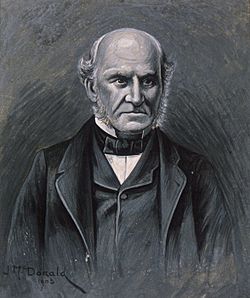James Busby facts for kids
Quick facts for kids
James Busby
|
|
|---|---|
 |
|
| British Resident in New Zealand | |
| In office March 1833 – 28 January 1840 |
|
| Bay of Islands councillor | |
| In office 1853–1855 |
|
| Bay of Islands councillor | |
| In office 1857–1863 |
|
| Personal details | |
| Born | 7 February 1802 Edinburgh,Scotland |
| Died | 15 July 1871 (aged 69) Anerley, London, UK |
| Spouses | Agnes Busby (née Dow; m. 1832) |
James Busby (born February 7, 1802 – died July 15, 1871) was an important person in the early history of New Zealand and Australia. In 1833, he became the first British Resident in New Zealand. This role meant he was the official representative of the British government.
Busby helped create two very important documents for New Zealand. These were the 1835 Declaration of the Independence of New Zealand and the 1840 Treaty of Waitangi. He is also known as the "father" of the Australian wine industry. He brought the first special grapevines from Spain and France to Australia.
Contents
James Busby's Early Life and Work
James Busby was born in Edinburgh, Scotland. His father, John Busby, was an engineer. In 1824, James and his family moved from Britain to New South Wales, Australia.
Learning About Grapes and Wine
When Busby arrived in Sydney, he became a teacher. He taught about viticulture, which is the science of growing grapes. He taught at a school near Liverpool. After his teaching contract ended, Busby received a land grant from the Governor. He chose land in the Hunter Region of Coal River.
In 1831, Busby went back to England. He then traveled to Spain and France. He wanted to learn even more about growing grapes and making wine. He returned to Australia in 1832.
Busby's Time in New Zealand
James Busby married Agnes Dow in New South Wales on November 1, 1832. In March 1833, the British government chose him for a special job. He became the British Resident of New Zealand. He arrived in the Bay of Islands on May 5, 1833, on a ship called H.M.S. Imogene. Agnes joined him in July.
Building a Home and a Vineyard
A house was built for Busby at Waitangi. Here, he planted some of the grapevines he had collected in Europe. These vines started producing wine in New Zealand even before his Australian vines did.
Busby's job was to protect British trade. He also had to help keep peace between the Pākehā settlers (European settlers) and the Māori in New Zealand. However, he did not have any soldiers or police to help him. This made his job very difficult.
Creating New Zealand's First Flag
One day, a New Zealand ship was taken in Australia because it didn't have a proper flag. Busby suggested that New Zealand should have its own national flag. Several flag designs were sent from Australia. At a meeting at Busby's home on March 20, 1834, Māori chiefs chose one design. This led to the creation of the United Tribes of New Zealand flag.
The Declaration of Independence and Treaty of Waitangi
In 1835, Busby found out that a Frenchman named Baron Charles de Thierry wanted to claim New Zealand for France. To prevent this, Busby wrote the Declaration of the Independence of New Zealand. In October, he and 35 chiefs from northern New Zealand signed this important document.
Later, in 1840, William Hobson arrived in New Zealand. Busby worked with Hobson to write the Treaty of Waitangi. This treaty was first signed on February 5 and 6, 1840. The signing happened on the lawn outside Busby's home in Waitangi.
Life After the Treaty
After the Treaty was signed, Busby and his family left Waitangi. He chose not to take a job in the new colonial government. Instead, he focused on farming. However, he had problems with his own land claims. His Waitangi property was taken, and Governor Grey took his land at Whangārei.
Busby also worked as a newspaper editor. In 1853, he was elected to the Auckland Provincial Council. He strongly believed that Auckland should be a separate colony from the rest of New Zealand. However, many people disagreed with him. Some newspapers even said his ideas were because of his land problems.
In 1860, he tried to become a member of the New Zealand House of Representatives. He ran for the Bay of Islands area but did not win.
Later Years and Legacy
James Busby died in 1871 in Anerley, England. He had traveled there for an eye operation. He is buried in London at West Norwood Cemetery. His wife, Agnes, returned to New Zealand. She died in 1889 and is buried in Paihia.
The Waitangi property, where the Treaty was signed, was not cared for until the 1930s. At that time, the Governor-General, Viscount Bledisloe, bought it. He then gave it to the nation of New Zealand.
Published Writings
- Treatise on the Culture of the Vine (1825)
- A Manual of Plain Directions for Planting and Cultivating Vineyards and for Making Wine in New South Wales (Sydney 1830)
- Journal of a Tour through some of the vineyards of Spain and France (Sydney 1833)
See also
 In Spanish: James Busby para niños
In Spanish: James Busby para niños

